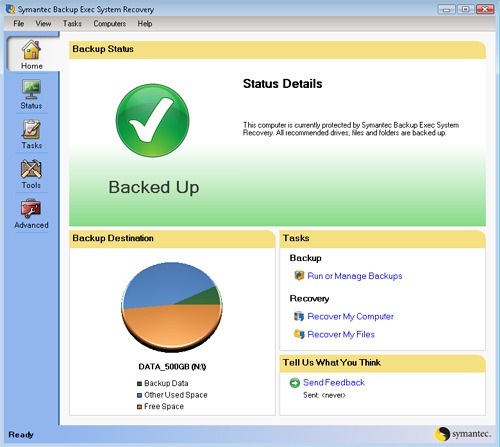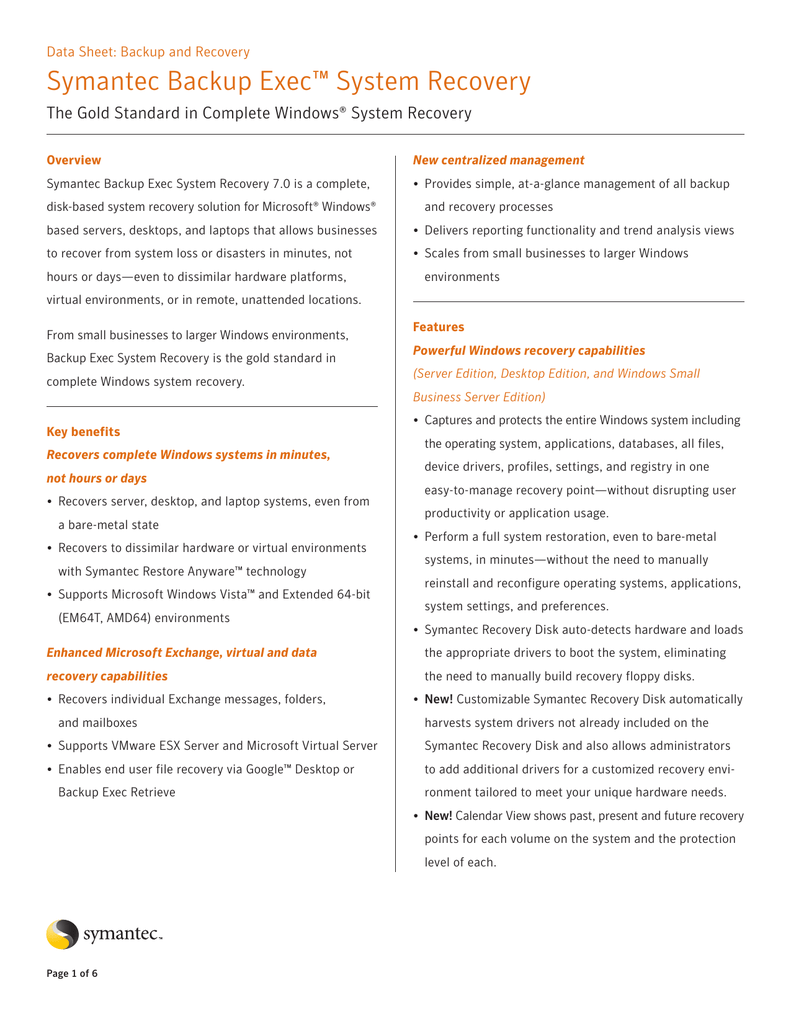
- How to restore file from symantec backup exec 2010 serial number#
- How to restore file from symantec backup exec 2010 install#
- How to restore file from symantec backup exec 2010 drivers#
- How to restore file from symantec backup exec 2010 upgrade#
- How to restore file from symantec backup exec 2010 full#
But the 1GB memory requirement for restoring from the boot disc limits its usefulness with older PCs.


It's a much better product than its Ghost predecessor thanks to the improved boot/recovery disc and its virtual hard-drive conversion. It's easy to use, but exposes relevant options better than Save & Restore. The one fly in the ointment is the requirement for a whopping 1GB of memory to do restore operations.Īnyone who's used Norton Save & Restore or Ghost will recognise the imaging engine and interface of BESR 2010. Windows has become increasingly more tolerant of hardware changes, but this is still a nice feature to have. In addition, it will restore images made on one PC to another PC whose hardware isn't the same.
How to restore file from symantec backup exec 2010 drivers#
It also contains a ton of drivers and lets you load those it doesn't immediately have available.
How to restore file from symantec backup exec 2010 install#
It's based on Windows PE 2 (Pre Install-what you see when you boot a Vista install disc), so it will boot on virtually any PC.
How to restore file from symantec backup exec 2010 serial number#
Finally, Symantec has seen the light (or the drop in sales), and Backup Exec System Restore allows you to image from the boot disc, albeit after entering your serial number each time.īecause it now allows imaging backup, BESR's boot disc is up there with the best in the business. Apparently when 2010 was installed, it was installed with a download from their website. Then of course, it asks for the 2010 installation disk. Open Backup Exec, go to options or something like that and uncheck it. Create a new policy, use the existing or new template, and choose incremental backup under Exchange and choose GRT backup.

Im not sure about Diff, But in order for you to use that GRT, you have to use the Symantec policy.
How to restore file from symantec backup exec 2010 upgrade#
Previously, Ghost and Save & Restore boot discs lacked that ability-you could only restore an image, or copy files off individually using a file browser, leaving a chance that you might overlook something. With that installed for 2010, you cannot upgrade to 2012 unless you remove it. Symantec Backup Exec 20 R2 does have a granular (GRT) backup available for incremental and full. This will allow you to modify the accounts credentials. If the account does exist, then select the account and click Edit. Next, check to see if a system logon account exists. Prudence suggests you should create a backup image backup before you try to fix or reinstall the operating system. To fix the problem, open Backup Exec and go to Configuration and Settings > Logon Accounts > Manage Logon Accounts. Say your friend brings you a PC that's still hardware-functional but won't boot into Windows. This is probably handiest for servers, but the server edition of BESR that also allows per-user restore of Exchange and Active Directory data is too expensive for many small businesses. If your system hardware goes belly up, you can mount these in a virtual machine on another PC and continue working. The compelling new feature of which I speak is the ability to convert BESR 2010 backup images to the VMWare. But it's also a substantially improved version that offers a compelling new feature as well finally addressing my longstanding and deal-killing complaint about Symantec imaging products: their inability to back up using the boot disc. That's right: Symantec's Backup Exec System Restore 2010 Desktop Version is an imaging product based on Norton Ghost. (At the time of writing there is currently no hotfix.Norton Ghost, meet Backup Exec.
How to restore file from symantec backup exec 2010 full#
Furthermore, it showed every single file and folder from the full virtual machine VMDK backup. Once the backup completed I went back into the restore wizard and Hey! Presto I now had an option to restore files and folders. It didn’t even matter what destination I used. In fact, I just backed up one, yes just one, tiny little file through the remote agent. To be able to do a GRT based restore from a backup using the VMWare agent I had to first do a one-time backup through the remote agent, treating the virtual machine as if it were a physical box.

I could only restore the entire virtual machine and all its virtual disks.Īpparently this is a known issue but there is a very simple workaround. There were no other options in the restore wizard. I also confirmed that the Remote Agent was deployed on the virtual machine and communicating correctly.īasically, when I selected the virtual machine in Backup Exec 2012 (because you do a GRT based restore through the Remote Agent) the restore wizard only had the option for a full virtual machine restore. The backups all reported as successful and I confirmed the GRT settings were configured in the backup options correctly. I ran into an issue recently where I could not do a GRT (file & folder) based restore from a backup that had been created using the VMWare Agent.


 0 kommentar(er)
0 kommentar(er)
